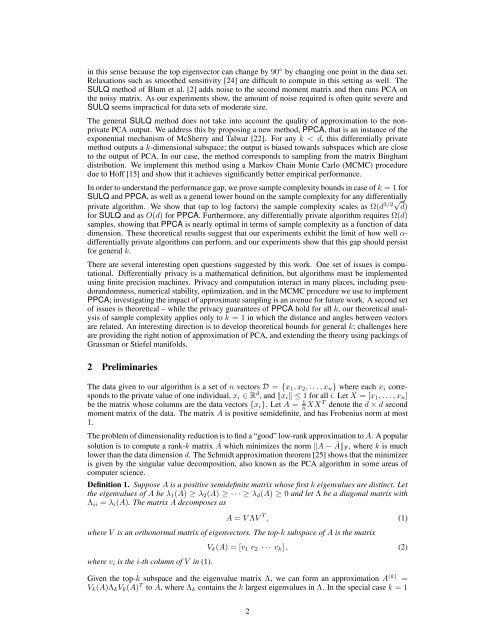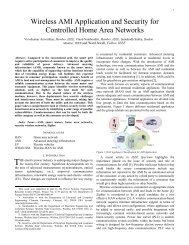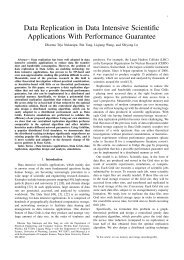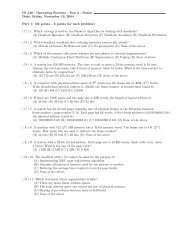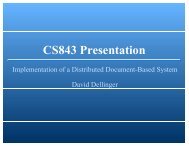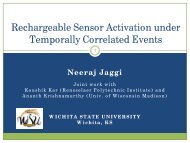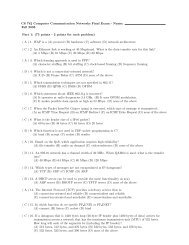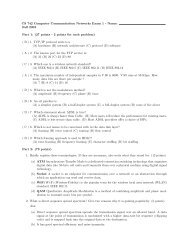in this sense because the top eigenvector can change by 90 by changing one point in the data set.Relaxations such as smoothed sensitivity [24] are difficult to compute in this setting as well. TheSULQ method of Blum et al. [2] adds noise to the second moment matrix and then runs PCA onthe noisy matrix. As our experiments show, the amount of noise required is often quite severe andSULQ seems impractical for data sets of moderate size.The general SULQ method does not take into account the quality of approximation to the nonprivatePCA output. We address this by proposing a new method, PPCA, that is an instance of theexponential mechanism of McSherry and Talwar [22]. For any k
we have A (1) = 1 (A)v 1 v1 T , where v 1 is the eigenvector corresponding to 1 (A). We refer to v 1 asthe top eigenvector of the data. For a d ⇥ k matrix ˆV with orthonormal columns, the quality of ˆV inapproximating A can be measured byq F ( ˆV )=tr⇣ˆV T A ˆV⌘. (3)The ˆV which maximizes q( ˆV ) has columns equal to {v i : i 2 [k]}, corresponding to the top keigenvectors of A.Our theoretical results apply to the special case k =1. For these results, we measure the innerproduct between the output vector ˆv 1 and the true top eigenvector v 1 :q A (ˆv 1 )=|hˆv 1 ,v 1 i| . (4)This is related to (3). If we write ˆv 1 in the basis spanned by {v i }, thenq F (ˆv 1 )= 1 q A (ˆv 1 ) 2 +dXi=2ihˆv 1 ,v i i 2 .Our proof techniques use the geometric properties of q A (·).Definition 2. A randomized algorithm A(·) is an (⇢, ⌘)-close approximation to the top eigenvectorif for all data sets D of n points,where the probability is taken over A(·).P (q A (A(D)) ⇢) 1 ⌘, (5)We study approximations to  that preserve the privacy of the underlying data. The notion ofprivacy that we use is differential privacy, which quantifies the privacy guaranteed by a randomizedalgorithm P applied to a data set D.Definition 3. An algorithm A(B) taking values in a set T provides ↵-differential privacy ifsupSµ (S |B= D)supD,D 0 µ (S |B= D 0 ) apple e↵ , (6)where the first supremum is over all measurable S ✓ T , the second is over all data sets D andD 0 differing in a single entry, and µ(·|B) is the conditional distribution (measure) on T induced bythe output A(B) given a data set B. The ratio is interpreted to be 1 whenever the numerator anddenominator are both 0.Definition 4. An algorithm A(B) taking values in a set T provides (↵, )-differential privacy ifP (A(D) 2S) apple e ↵ P (A(D 0 ) 2S)+ , (7)for all all measurable S✓T and all data sets D and D 0 differing in a single entry.Here ↵ and are privacy parameters, where low ↵ and ensure more privacy. For more details aboutthese definitions, see [9, 26, 8]. The second privacy guarantee is weaker; the parameter bounds theprobability of failure, and is typically chosen to be quite small.In this paper we are interested in proving results on the sample complexity of differentially privatealgorithms that approximate PCA. That is, for a given ↵ and ⇢, how large must the number ofindividuals n in the data set be such that it is ↵-differentially private and also a (⇢, ⌘)-close approximationto PCA? It is well known that as the number of individuals n grows, it is easier to guaranteethe same level of privacy with relatively less noise or perturbation, and therefore the utility of theapproximation also improves. Our results characterize how privacy and utility scale with n and thetradeoff between them for fixed n.Related Work Differential privacy was proposed by Dwork et al. [9], and has spawned an extensiveliterature of general methods and applications [1, 21, 27, 6, 24, 3, 22, 10] Differential privacyhas been shown to have strong semantic guarantees [9, 17] and is resistant to many attacks [12] thatsucceed against some other definitions of privacy. There are several standard approaches for designingdifferentially-private data-mining algorithms, including input perturbation [2], output perturbation[9], the exponential mechanism [22], and objective perturbation [6]. To our knowledge, other3


